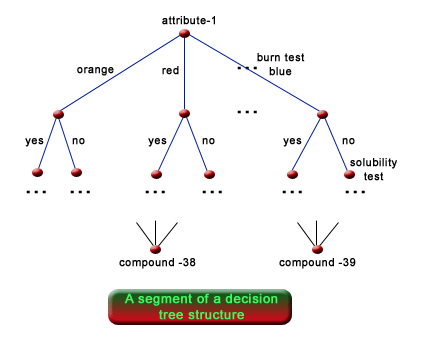|
When knowledge can be structured in a top-to-bottom manner,
it may be stored in the form of a decision tree. For example,
the identification of objects (equipment faults, physical
objects, diseases, and the like) can be made through a decision
tree structure. Initial and intermediate nodes in the tree
correspond to object attributes, and terminal nodes correspond
to the identities of objects. Attribute values for an object
determine a path to a leaf node in the tree, which contains
the object's identification. Each object attribute corresponds
to a nonterminal node in the tree and each branch of the decision
tree corresponds to an attribute value or set of values.
A segment of a decision tree knowledge structure taken from
an expert system used to identify objects such as liquid chemical
waste products is illustrated in the following figure.

Each node in the tree corresponds to an identifying attribute
such as molecular weight, boiling point, burn test color,
or solubility test results. Each branch emanating from a node
corresponds to a value or range of values for the attribute
such as 20-37 degrees C, yellow, or non soluble in sulfuric
acid.
An identification is made by traversing a path through the
tree (or network) until the path leads to a unique leaf node
which corresponds to the unknown object's identity.
|